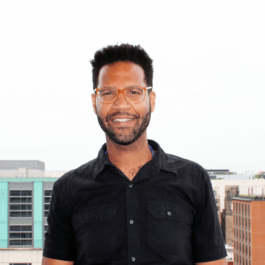In a brick-and-mortar business owner’s mind, e-commerce startups are tough to compete with. Driven by young visionaries, these startups are intent on disrupting the status quo, often with little regard for shopkeepers who lack the technological know-how to keep up.
Allison Baker is sympathetic to these shopkeepers’ plight — and the skepticism she faces in her work to help them stay competitive. As the senior director of account management at retail technology company Upside, Baker works directly with small business owners to leverage the sophistication of online retail — profit measurement, attribution and incrementality — to entice customers with cash-back incentives, merchants with proven profit and both with the upside of protecting our planet.
“I was just in Tennessee with a client who runs a fuel station, and she insisted that she knew all of the customers who came to this one rural site,” Baker recalled recently. “She said, ‘They’re loyal, and if they’ve been here once, they’ve been here multiple times.’ She didn’t see the value in using digital tools to bring in new business.”
But the information gathered by Upside told a different story. “When we looked at the data, a substantial percentage of the customers at that site were new or infrequent, and it was very eye-opening for her to squash that concern,” Baker said. All of a sudden, a service like Upside — delivering personalized promotions that drive traffic to participating merchants — became an invaluable tool for someone who may not have the resources or the inclination to focus on digital marketing.
“While the data we provide them sometimes seems super basic to running a business, a lot of times it’s information they’ve never been able to access,” Baker continued. “When we can aggregate that data in a way that positively impacts our merchants, everyone wins. The work we do allows our communities to thrive.”
WHAT UPSIDE DOES
Upside, in this way, is not just leveling the playing field for local businesses — it’s leveling up the playing field. The Washington D.C.-headquartered company has generated $300 million in cash back for users and $650 million in profit for merchants since its founding in 2016, all while committing 1 percent of its revenue to sustainability initiatives related to its areas of operation.
“Our product has made a big difference in peoples’ lives, especially when you consider the past few years,” Senior Software Engineer Willie Miller said. “Having these tangible examples of the way our work is putting money into people’s pockets and bank accounts is really rewarding. Everything that we’re working on goes into that: Every tweak in the API, every tweak in the algorithm and everything else we’re improving all feeds into a better user experience.”
Built In met with Miller, Baker and Co-founder and Chief Technology Officer Joanna Kochaniak to learn how Upside is bringing personalization to brick-and-mortar commerce, and how the company does its part behind the scenes to transform everyday purchases into greater change.

How do you translate your company mission into specific actions for both the company and individual teams?
Senior Director of Account Management Allison Baker: On my team, which manages accounts with our fuel merchants, we really preach that this is a win-win-win scenario for our consumers, merchants and communities. It’s really cool that what we do — and the impact that we provide for our merchants — directly correlates to the consumers.
Senior Software Engineer Willie Miller: From our perspective on the consumer-facing engineering side, I can see that this thing I’m working on is driving more users to engage with the platform, which means more users are going to participating merchants. The quality of the experience, whether we look at it from pure metrics or from a user perspective, just drives the whole consumer side of the platform, and that pushes up the rest of this sort of triangle of goodness for us.
How meaningful is it to work on a product that has such a big impact on the people who use it?
Co-founder and CTO Joanna Kochaniak: It is incredibly empowering to work on a product that has a proven impact on both merchants and consumers. I love reading comments and hearing stories from customers about how we have helped their dollars go farther or helped increase profits in their business. Knowing the impact we are having on people, especially during tough economic times, helps motivate our team to work hard and ensure we are always putting the needs of our customers first.
It is incredibly empowering to work on a product that has a proven impact on both merchants and consumers.”
Miller: It means your work matters. If you’re working on something as a company that is helping somebody directly, then it means you matter to that person who needs the money they’re getting back from gas purchases or groceries or restaurants. It feels good because it’s important to somebody. It’s important to many people, honestly. It doesn’t get much better than that.
What does it say about Upside that its business revolves around helping other businesses succeed as well?
Kochaniak: There’s a long line of discount products and apps that give money away to users that were already going to make a given purchase. That model is not personalized to the customer and is damaging to the merchant. Instead, Upside is a tool that ensures each transaction is measurably beneficial to both the customer and the merchant.
Baker: That’s something that we think about every day. When we have our monthly call with the entire company, our leadership reinforces the impact that we make on the consumer side, on the merchant side and in the communities in which we operate.
UPSIDE’S IMPACT
What product has your team created that’s unique to Upside?
Miller: When I first joined the company a couple years ago, users still had to upload a receipt to take advantage of our platform. Everything was based on uploading a receipt, which can be a pain to get from some places, especially restaurants. I was on the team that did the first round of receiptless transactions at fuel sites. That had a huge impact. Now a user just needs to give us a little more information up front, and they don’t have to upload a receipt. Working on that project was really cool, and now it’s the default for our entire fuel product. It’s hard to overstate how big of an impact that’s made on the company.
Kochaniak: We were processing 10 to 20 receipts a day when Upside first started, and having to do it manually. As the number of receipts kept increasing — which showed that more consumers were finding value with our product — I remember thinking that if we ever get to a place where we are processing 1,000 receipts a day, that is when we’ve “made it.” Today, we process over 100,000 receipts a month, and that doesn’t even factor in transactions that are processed without receipts. Today over 350,000 transactions are made each day on the Upside platform. It still feels surreal when I see these numbers and how we have grown compared to the early days when starting the company.
What has the response been from merchants who use your product?
Baker: A lot of times merchants will assume we’re sending them customers they would have received otherwise, or who were already loyal to their sites. They assume that now these customers are getting a discount and they’re cannibalizing their margin as a result of working with us. But when we dive into the specifics of who these customers are, a lot of times 80 to 90 percent of them are new or infrequent customers. When we show them the data, they say it’s hard to believe. I think that really hones in on the value we provide: We’re sending you customers who had never come to your store before, or who are now purchasing more because of us.










.png)